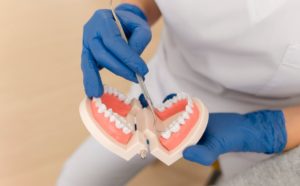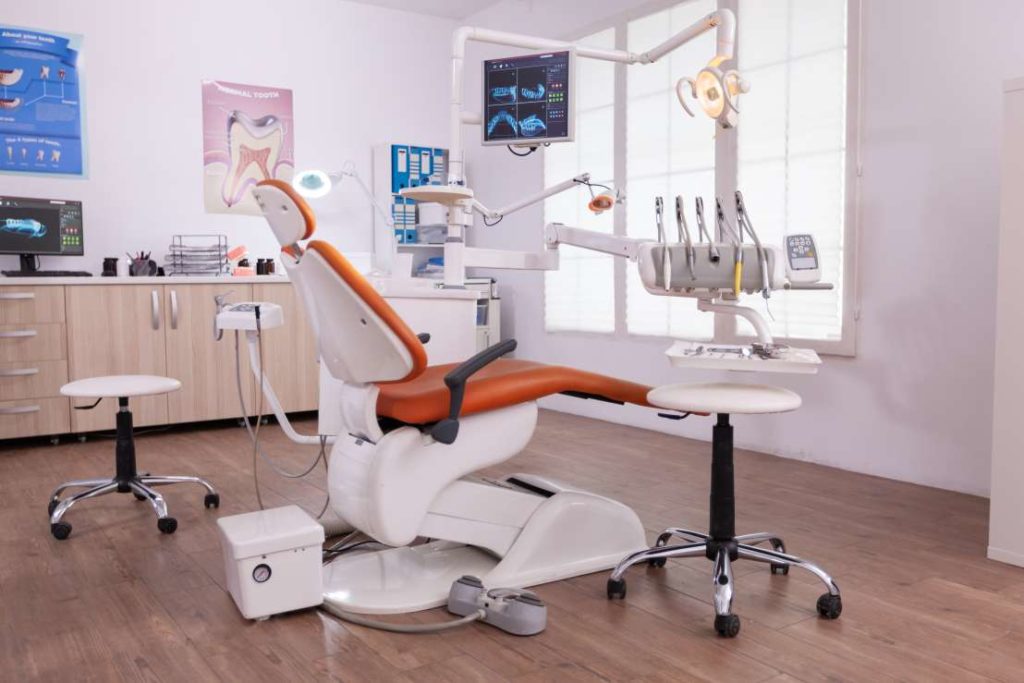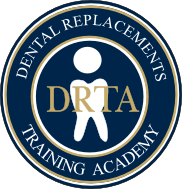Dental Assistant School Dallas
Dental Assistant Terminology A-Z
When providing care to patients, keeping patient records, and creating claims, dental assistants and dentists communicate using a variety of words. It can be challenging to understand medical jargon at times, so taking the time to become familiar with some of the most typical dental phrases can be quite beneficial.

Dental Assistant Terminology: Most Common Terms
The terms used often in the dentistry industry are listed here for your reference as you learn more about it. We will go more in depth in areas where a dental assistant is more likely to assist a dentist.
During the majority of dental treatments, local anesthetic, usually referred to as Novocain, is employed. The anesthetic will be injected by the doctor, and it will temporarily numb the patient and stop the nerve impulses from traveling through the tooth fibers.
Dental abrasion occurs when the teeth begin to lose enamel as a result of any form of mechanical impact from the outside. The forces put on the teeth are most likely to blame for this.
An abscess is a dental, soft tissue, or bone infection that can be acute or persistent. In essence, it is an accumulation of pus that develops inside the teeth or gums. It develops from an infection caused by bacteria that has built up in the sensitive pulp of a tooth.
The curvature of each jaw’s row of teeth is known as a dental arch. It also goes by the name “arcade.”
Premolar teeth, commonly known as bicuspid teeth. They have two cusps and are situated at the rear of the mouth between the canines and the molars. Their major function is to facilitate chewing and biting.
Events that occur on both the left and right sides.
A dental biopsy involves the excision of a tissue sample to check for the presence of disease. A doctor will take a sample of tissue from the gums during a gum biopsy. The sample is subsequently delivered to a lab for analysis.
A Bite-wing is an x-ray displaying top and bottom teeth in one film.
To modify a tooth’s color, shape, or both via bonding, a composite resin is applied. The application of various fillings or dentures to the teeth might also be discussed.
A cavity, also known as a carious lesion, is a degradation in tooth structure and enamel brought on by caries. They are little holes and openings on the hard surface of teeth that are permanently destroyed. There are several possible causes of tooth decay, or caries. They could be brought on by oral germs, poor dental hygiene, and a diet high in sugary foods and drinks.
A canal is a small tube-shaped passageway. Mandibular canals and root canals are two examples of the various types of canals.
Any of the four teeth, one on each side of the upper and lower jaws, situated between the lateral incisor and the first premolar.
This is a phrase for dental decay that is frequently used.
The dentin of the root is lined by cementum, a mineralized tissue that resembles bone and guards the root. It also functions as a surface for attachment to another. The periodontium, which connects the teeth to the alveolar bone, is responsible for this.
Composite is a dental restorative substance composed of many components.
A crown is a synthetic restoration that replaces lost tooth components. The materials used to make the crown are metal, ceramic, or polymer. It is applied by the dentist using luting cement. Crowns come in a variety of styles. There are crowns made of metal, ceramic, porcelain, and gold.
Single cusped tooth located between the incisors and bicuspids.
A cyst is a cavity that is filled with fluid or soft tissue and is bordered with the epithelium.
Connective tissue that contains blood vessels and nerve tissue which occupies the pulp cavity of a tooth.
The majority of the tooth is made up of the dentin, a tough and thick bone substance. It is situated below the enamel.
A denture replaces lost teeth and supporting tissues artificially and detachable. There are two different kind of dentures. When all of the teeth are missing, complete dentures are utilized, while partial dentures are used when just some natural teeth are missing.
Decomposition of tooth structure is another name for the lesion known as decay in a tooth.
The tooth’s delicate exterior is enamel. It covers the crown and is transparent, allowing light to pass through.
Dental erosion, which does not include microorganisms, is the permanent loss of dental hard tissue caused by acids. Acids eat away at the tooth enamel, causing this. Consuming a lot of acids might cause it.
An extraction from the mouth of one or more teeth is referred to as a dental extraction. A dental surgeon often performs this surgery.
One prevalent type of gum disease is gingivitis (also called periodontal disease). It may result in swelling, redness, and discomfort. The gingiva, the area of your gum at the base of your teeth, is where the inflammation is most prominent. The dental assistant is in a great position to inform patients about the value of maintaining good periodontal health, which will improve treatment outcomes and boost the hygiene and restorative departments’ financial success.
Health Insurance Portability and Accountability Act (HIPAA) of 1996; A federal law that includes Administrative Simplification Provisions that require all health plans, including ERISA, as well as health care clearinghouses and any dentist who transmits health information in an electronic transaction, to use a standard format.
An unerupted or partially erupted tooth that is positioned against another tooth, bone, or soft tissue so that complete eruption is unlikely.
Dental implants are man-made metal posts or frames that are implanted surgically into the jawbone behind the gums.
A cast can be created from an impression, which is an imprint of the mouth’s soft tissues and teeth. It is typically made by putting a substance in a unique tooth imprint tray. To fit over the dental arches, it is made to do so.
Intraoral The interior of the mouth is referred to as intraoral. Patients can observe issues with their teeth and/or gums, such as rusted or tarnished fillings, broken teeth, etc., thanks to intraoral cameras (IO cameras), which create precise pictures of teeth and the supporting tissues.
An oral lesion is an ulcer that develops on the oral activity’s mucous membrane. Cavities are the root cause of tooth decay.
Inflammation and destruction of the connective tissue around the teeth are symptoms of periodontitis. The teeth might loosen or even fall out if the framework is lost.
The connective tissue that fills the pulp cavity of a tooth is called pulp. It has nerve tissues and blood vessels.
An x-ray is a radiograph.
Primarily, you will focus on providing dental care for patients and ensuring that the office is functioning optimally. To start working as a registered dental assistant, you need the proper degree from one of the dental schools in Dallas, Texas. Here are a few of the skills you will learn at our Dental Assistant school in the Dallas area:
- Speaking to patients when they arrive and ensuring they feel comfortable
- Asking patients about their medical history
- Aiding the dentist to perform different procedures
- Ensuring that the dental equipment is sterile
- Following proper instructions to prevent infections
- Helping patients understand the steps of the procedure
- Taking dental X-rays of patients
- Taking impressions of teeth for molds
- Handling office organization, including taking appointments
- Maintaining inventory supplies
The part of the tooth that is inside the socket is called the root.
The pulp-filled space in a tooth’s root is known as a root canal. People often undergo this surgery to remove contaminated pulp from a root canal and replace it with a specific substance.
Root canals are handled in a special field known as endodontics. Endodontists examine the inner pulp of a person’s teeth to ensure their health. They’re also responsible for performing root canals on diseased teeth and diagnosing the source of tooth pain. However, while they may differ from traditional dentists, they still require just as much assistance when working with patients.
The right method for treating gingivitis at the dentist is taught in dental assistant training. Scaling and root planing is the name of this method. Due to the length of these treatments, often only half of the mouth is treated in a single session. Scaling includes using a tiny, portable metal tool called a scaler to remove tartar from both above and below the gum line. Root planing generally involves cleaning the teeth to remove rough regions that are prone to collect germs. A dentist could utilize lasers to vaporize and remove damaged tissue during scaling and root planing. Additionally, this laser will eliminate any remaining bacteria in your mouth. Extreme instances of gingivitis may require surgery to peel back the gums and remove plaque that is difficult to reach. It is crucial that the dental assistant be as knowledgeable about the disease and its treatment as the dentist is throughout any dental operation. Programs for dental assistants will make sure of it. You could get numbing medication from a dental assistant throughout the operation. Some dental assistants will receive training so they can handle simple scaling operations on their own. Overall, a dental assistant will help the dentist during the whole treatment.
An application of plastic to the teeth’s surface is known as a sealant. It’s a UV-cured epoxy that coats cracks in teeth to shield them from cavities and dental deterioration. When applying sealants, the dental assistant is a crucial element of the team. The stages for applying sealant are also the first steps in handling bonded composite resins when establishing skill competencies; as a result, training for future restoration treatments may start with sealant application. The dental assistant adds a new degree of professional knowledge to the clinical context by being technically competent. The goal of dentistry is to promote optimal oral health, and placing quality sealants on patients helps them avoid cavities.
An inflammation of the mouth and lip mucous membranes is called stomatitis.
Transferring biological material across sites via surgery.
A tooth that has not yet erupted is said to be unerupted.
One-sided; relating to or having an impact just on one side.

Dental Assistant Salary
How Much Do Dental Assistants Make?
Reports place dental assisting as the 20–25 best healthcare support jobs. Over the past few years, the salary of dental assistants increased considerably. For instance, the median salary in 2017 was around $37,160. Today, it’s over $45,000.
According to the Bureau of Labor Statistics, around 64,600 jobs will be open between 2016 and 2026. That’s an employment growth of 19.5%.


How Do You Become a Dental Assistant in Texas?
As you may expect, becoming a dental assistant requires a degree. This is a medical practice that involves aiding in complicated procedures and optimizing office functions.
What’s the first step to becoming a registered dental assistant? Well, enrolling in one of the best dental assistant schools in Texas.
Our school, at Dental Replacements Training Academy, will ensure that you get a top-notch, personal, hands-on learning experience. You will learn all the necessary skills to excel in this field. You can also apply for online courses if you have a busy schedule. As we said earlier, you don’t have to leave your current job while training for a position in dental assisting.
Today, our online classes provide a high-quality teaching experience to let passionate people follow their dreams of joining the dentistry world.
Before you make this decision, however, let us cover the pros and cons of online dental assisting schools in Texas.
Our dental assistant program provides everything you need to start your new career as a Dental Assistant today!
- Next Class Starts On June 3, 2024 – Enroll Now!
